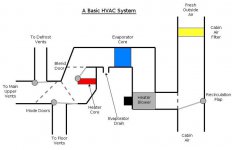- Joined
- Jan 20, 2013
- Messages
- 1,537
- Points
- 276
However what we are talking about In relation to the above article is a early 2000s car, more specifically an 8.1 litre SUV which looks something like this
View attachment 182395
It's probably worth noting that the design of these cars also relates back to the 80s and even 70s without any major update to the shape and aerodynamics. Just for comparison here is a 70s version
View attachment 182396
There's a thing aerodynamicists talk about called detail optimization. Those two look little alike aerodynamically. Somewhat ironically I could say exactly the same thing about the 60's 500 vs today's.
Fact remains the tech on a suburban released in 2000 is about the same as that on a Panda in 2003, hardly 'much newer'.
Finally if you put any car in any gear and floor it with the aircon off, and with the air con on, there should be no noticeable difference between the two as cars are designed to kill the AC at wide open throttle to give maximum power to the engine, as long as your foot is buried in the carpet, you won't have aircon.
I don't think you've ever driven a car, or at least not a 4 cyl. The vast majority of cars I've driven don't do this. My TA does, my Trafic does, but the Suzuki, Proton, Nissan, Mercedes, VW, Jeep & Renault don't/ didn't.
I don't know where your figures are from, but wikipedia lists the 2006 Tahoe Hybrid at .038, a Tahoe is a short Suburban. All else being equal, the better fineness ratio of a Suburban should help it over a Tahoe. Nothing short of a Jeep Wrangler (completely flat windscreen, massive flat grill, massive tyre flares) has a Cd of 0.45. You have to go well back into the 70's to find anything like that.
I already addressed CdA. The CdA of a Suburban is about double of a 500, but it's engine nearly 7 times larger, no wonder the A/C barely made a difference to it's economy, a bit of load just means it's operating in at a higher BMEP.
Fact remains, there's not a single paper any where that claims A/C usage is too small a factor to consider or measure. Fact remains the sedans tested showed similar results.
My previous Renault was rated 9.7 city, it returned 6.7 over the 20K that I had it, and that includes trailer towing. My lifetime average speed as recorded by my GPS was 26km/h- dead on for the NEDC city number. How far over NEDC are you averaging with your A/C always on?
The only possible point of debate is what speed is the cross speed in A/C on vs windows down. Only a few internet experts claim otherwise.
And I'd argue that the 500, basically a 2003 car (and it takes about three years to go into production), isn't really as modern as you'd have me believe. Most of your arguments might have some weight on a diesel S Class or something, but they almost have no relation to a 500.
You know, sedans showed similar results, so why bang on about the SUV???
Last edited:



